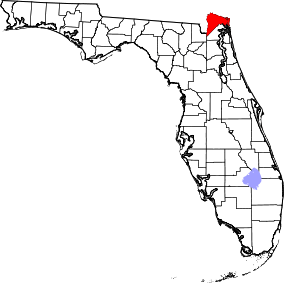American Beach, Florida
|
American Beach Historic District | |
 | |
  | |
| Location | American Beach, Florida |
|---|---|
| Coordinates | 30°34′24″N 81°26′46″W / 30.57333°N 81.44611°WCoordinates: 30°34′24″N 81°26′46″W / 30.57333°N 81.44611°W |
| Area | 40 acres (16 ha) |
| Built | 1935 |
| Architect | Patterson, George; et al. |
| Architectural style | Colonial Revival, Frame and masonry vernacular |
| NRHP Reference # | 01001532 |
| Added to NRHP | January 28, 2002[1] |
American Beach is a historic beach community popular with African-American vacationers. It is located north of Jacksonville, Florida on Amelia Island in Nassau County. During the time of segregation and the Jim Crow era, African Americans were not allowed to swim at most of beaches in Jacksonville, and several black-only areas were created. American Beach was the largest and most popular, and was a community established by Abraham Lincoln Lewis, Florida's first black millionaire and president of the Afro-American Life Insurance Company.[2] It contains American Beach Historic District.


History
American Beach was founded in 1935 by Florida's first black millionaire, Abraham Lincoln Lewis, and his Afro-American Life Insurance Company.[3] The plan was for his employees to have a place to vacation and own homes for their families by the shore.[2] Throughout the 1930s, 1940s, and 1950s, summers at American Beach were busy with families, churches and children. It was a place where African Americans could enjoy "Recreation and Relaxation Without Humiliation". The beach included hotels, restaurants, and nightclubs as well as homes and other businesses.[4]
American Beach played host to numerous celebrities during this period, including: folklorist Zora Neale Hurston, singer Billie Daniels, Cab Calloway, Ray Charles, Billy Eckstein, Hank Aaron, Joe Louis, actor Ossie Davis,and Sherman Hemsley . James Brown was actually turned away from performing outside Evans' Rendezvous, a nightclub on the beach. In 1964, American Beach was hit hard by Hurricane Dora, and many homes and buildings were destroyed. The passage of the Civil Rights Act that same year desegregated the beaches of Florida, and American Beach became a less and less popular vacation destination as more African American Jacksonvillians turned to locations nearer their homes.[5]
A.L. Lewis' great-granddaughter MaVynee Betsch, known to locals as the Beach Lady, returned to American Beach in 1977 to fight for its preservation. For years, she planted trees along Lewis street, offered historical tours of the beach, and fought to raise public awareness of the beach and its struggle until her death September 2005. She wanted to make American Beach a monument to black Americans' determination to overcome the obstacles of the Jim Crow era. As of January 2001, American Beach is listed as a historic site by the National Register of Historic Places.
Historic district
American Beach Historic District is a U.S. historic district in American Beach. It is roughly bounded by Gregg, Lewis, Leonard, Main and James Streets, and Ocean Boulevard, encompasses approximately 400 acres (1.6 km2), and contains 67 buildings and one structure. On January 28, 2002, it was added to the U.S. National Register of Historic Places.
Fictional portrayals
- Janice Sims, That Summer At American Beach, (2006) ISBN 1-58314-627-X
- Sunshine State, Film directed by John Sayles (2002) Sunshine State (film)
References
- ↑ National Park Service (2009-03-13). "National Register Information System". National Register of Historic Places. National Park Service.
- 1 2 Cottage Living page 144- month?
- ↑ "History of American Beach: African American determination". National Park Service. Retrieved 12 February 2016.
- ↑ "History of American Beach: A Minority at its Leisure". National Park Service. Retrieved 12 February 2016.
- ↑ "History of American Beach: 1964, Beginning of the End". National Park Service. Retrieved 12 February 2016.
- Marsha Dean Phelts, An American Beach for African Americans, (1997) ISBN 0-8130-1504-9
Further reading
- Russ Rymer, American Beach: How "Progress" Robbed a Black Town—and Nation—of History, Wealth, and Power, (2000) ISBN 0-06-093089-6
- Russ Rymer, American Beach: A Saga of Race, Wealth, and Memory, (1998) ISBN 0-06-017483-8
External links
- Nassau County listings at National Register of Historic Places
- Nassau County listings at Florida's Office of Cultural and Historical Programs
-
 Media related to American Beach, Florida at Wikimedia Commons
Media related to American Beach, Florida at Wikimedia Commons -
 Media related to American Beach Historic District at Wikimedia Commons
Media related to American Beach Historic District at Wikimedia Commons
